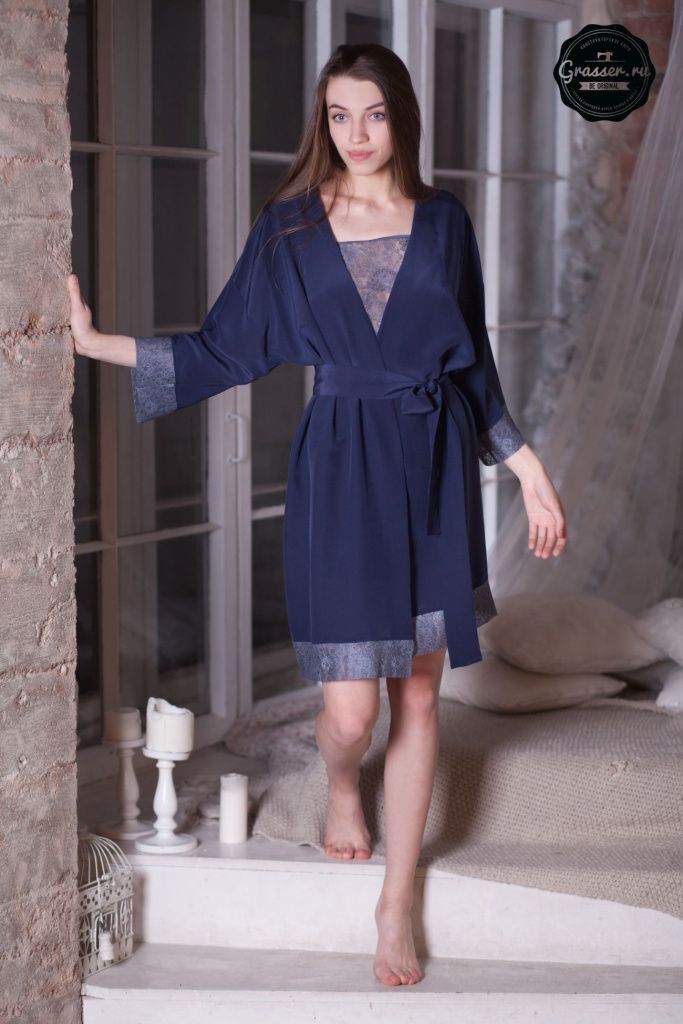Create Your Comfort with Dressing Gown Sewing Patterns
There is a special charm in sinking into a dressing gown that has been sewn by your own hands. Let's imagine a cozy Sunday morning, the steam rising from a cup of coffee, and the soft embrace of a robe sewn exactly to your taste. No store-bought garment can replicate that feeling. We at Grasser have spent years creating patterns for seamstresses who crave comfort and customization. Our dressing gown sewing patterns are more than just instructions, they are an invitation to create something uniquely yours.

Why Your Hands Should Stitch This Robe
Let's talk about bathrobes - or, as they are popularly called, dressing gowns for the home.
Unlike fitted dresses or pants, they forgive small mistakes. For example, the first robe may have uneven sleeves, but nevertheless, it can be proudly worn for years. Want to step it up a notch? Try French stitching to give the piece a luxurious look, or add embroidered initials - a technique we're sure many seamstresses are employing.
Dive Into Grasser’s Homewear Collection
Before you thread your needle, explore our sleepwear sewing patterns: floaty nightgowns, matching pajama sets, and yes, more robe designs. The Grasser catalog even has a pattern for a knit robe that feels like a cloud (Pro tip: pair it with our lace-trimmed nightie for a gift your best friend will adore.)
Meet Pattern №416: The Robe That Feels Home
Our PDF dressing gown pattern №416 is one of our favorite cutouts. You can't count how many variations there are: one made of cherry-coloured cotton is suitable as a gift, for example, for your sister's anniversary, another one made of dark blue fleece is a gift for a friend in the cold winter. A shawl collar? It's just a fabulous thing. And the sizes allow everyone to enjoy comfort - for different figure types. It's safe to say that our housecoat patterns are an ideal project for beginners.
Key features and why seamstresses love it:
-
The flexibility of the fabric: Perfect for showing off bright prints, using linen or experimenting with textures. The pattern is suitable for both lightweight cotton fabrics and heavier fabrics such as fleece.
-
Beginner-friendly: Clear instructions guide you through the finishing process using standard zigzag stitching - no overlock required.
-
Personalization options: Accessorise the dressing gown with a contrasting belt (polka dots make a playful accent) or braid in bold colours. If you're looking for inspiration or ready-to-use designs, consider downloading a dressing gown sewing pattern in PDF—many include stylish accessory suggestions to elevate your creation.
Materials needed for sewing:
-
Materials: 2.5 metres of fabric (pre-washing is recommended to prevent shrinkage).
-
Notions: Matching or contrasting ribbon.
-
Atmosphere: Complement the sewing process with a compiled playlist - jazz or podcasts will liven things up while you create the collar.
Where to find it? Download a PDF of the dressing gown pattern №416 of different sizes (from 38 to 56) and for every woman’s height (from 158 to 176). Let's grab a pair of scissors!

Stitching Your Robe: A Labor of Love
1. Cutting Preparation
Start by laying out the fabric with the correct side down. Secure the pieces with glass-headed pins to avoid snags, and mark each piece with chalk so you don't mix up the sleeves with the facing sides - a mistake that can ruin hours of progress.
2. Shoulder Seams
Sew shoulders using a precise 1.5 cm seam allowance for a clean finish. Press seams open with a steam iron; the tactile satisfaction of crisp, flat seams is unmatched.
3. Collar Construction
This step introduces a touch of elegance. Fold, stitch, and flip the collar carefully, then secure the bias tape with a slip stitch. The crisp finish will bring quiet satisfaction every time you slip the robe on.
4. Belt Loops & Details
Attach loops at the waist for functionality or omit them for minimalist appeal. Personalize your piece with subtle embroidery—one of our readers once discreetly stitched her cat’s name into the hem, a charming hidden signature.
5. Fabric Selection: The Foundation of Character
-
Knit Fabrics: Embrace stretchy, forgiving knits for adaptable comfort—ideal for relaxed wear.
-
Linen: Celebrate its organic texture; let wrinkles form naturally for effortless sophistication.
-
Terry Cloth: Elevate with a flannel lining for winter-ready coziness.
6. Next Steps
Once complete, explore complementary sleepwear patterns: a flowing kimono-style nightgown or tailored pajamas with discreet pockets (perfect for midnight snacks).
This guide balances precision with creativity, transforming a simple robe into a testament to mindful craftsmanship. Happy stitching.
Download the dressing gown sewing pattern in PDF format right now!
Sewing a PDF dressing gown pattern isn't just about grabbing thread and fabric. It's the process of creation - the feeling of pride when someone asks: ‘Did you sew that?!’. At Grasser, we’re not just selling patterns—we’re sharing a passion for slow, intentional crafting. So take your time. Savor each stitch. And remember every imperfection? That’s where the charm lives.
Happy stitching, friends.









